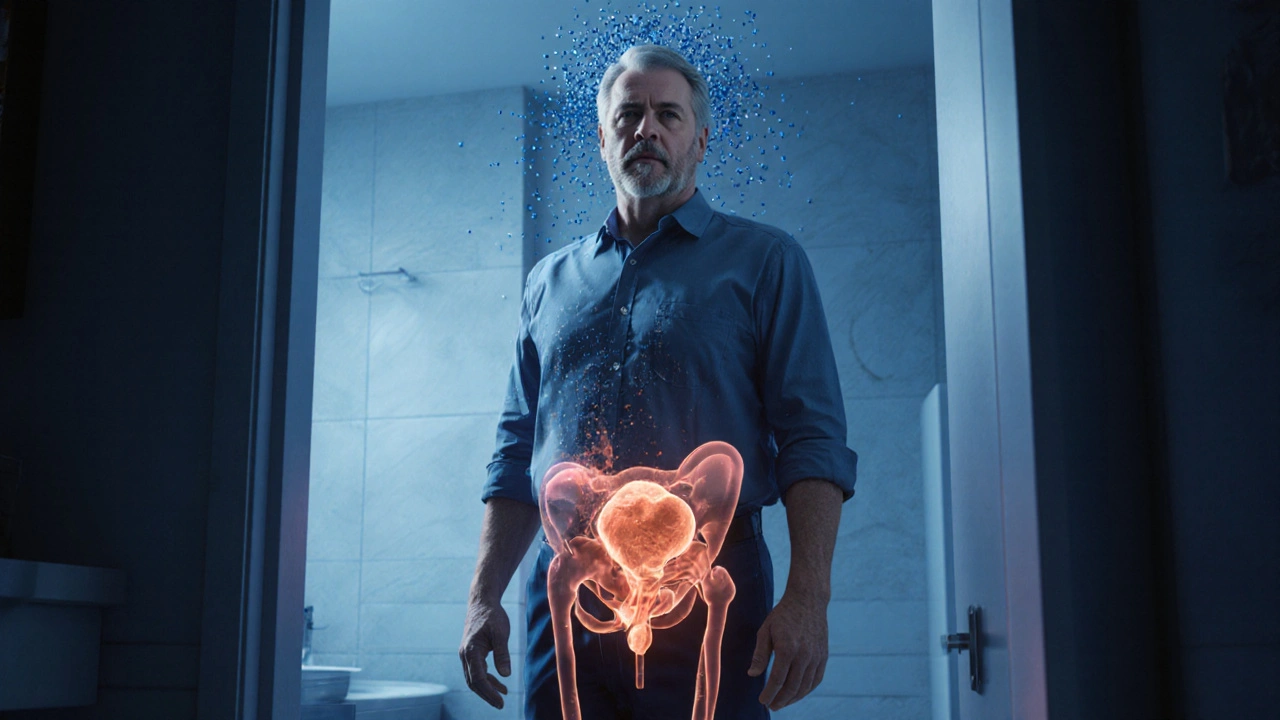
BPH Symptom Tracker
Daily Symptom Log
Your Daily Progress
Your Progress Trend
How this helps: Your daily entries create a personalized baseline. Consistent logging shows patterns between your yoga/meditation practice and symptom changes.
Finding relief from an Enlarged Prostate is a common challenge for many men as they age. While medication and surgery are often discussed, a growing body of evidence shows that simple mind‑body practices can play a big role in easing symptoms. Below you’ll see how Yoga and Meditation act on the body’s stress pathways, improve pelvic muscle tone, and support overall urinary health.
Understanding the Prostate and Why It Swells
The prostate is a walnut‑sized gland that sits just below the bladder. When it grows-a condition medically called Benign Prostatic Hyperplasia (BPH)-it can press against the urethra and cause Lower Urinary Tract Symptoms (LUTS) such as frequent urination, urgency, and a weak stream. Hormonal changes, chronic inflammation, and lifestyle factors all contribute to this buildup.
How Stress Fuels Prostate Problems
Stress isn’t just a feeling; it triggers the release of the hormone Cortisol. High cortisol levels can increase inflammation in the prostate tissue and tighten the smooth muscle around the urethra, making symptoms worse. Moreover, stress activates the sympathetic nervous system, which opposes the Parasympathetic Nervous System. The parasympathetic branch promotes relaxation, improves blood flow, and helps the pelvic floor muscles unwind-key actions for a healthy voiding pattern.
Yoga’s Direct Benefits for Prostate Health
Yoga blends gentle movement, controlled breathing, and a meditative mindset. Here’s why it matters:
- Pelvic Floor Activation: Poses such as Bridge and Happy Baby target the Pelvic Floor Muscles. Strengthening these muscles improves urinary control and reduces urgency.
- Reduced Inflammation: Consistent practice lowers systemic markers like C‑reactive protein, which correlates with prostate inflammation.
- Lower Blood Pressure: Many yoga styles trigger a parasympathetic response, bringing down Blood Pressure and easing the extra pressure on the bladder neck.
- Enhanced Breathing: Breathing Techniques such as diaphragmatic breathing stimulate the vagus nerve, which further calms cortisol release.
Meditation’s Role in Managing Symptoms
Meditation doesn’t involve physical movement, but it reshapes the brain’s stress circuitry. Regular sessions (10‑20 minutes daily) have been shown to:
- Decrease cortisol by up to 30% (studies from the University of California).
- Boost the production of Alpha-Blocks‑like relaxation neurotransmitters that relax the prostate’s smooth muscle.
- Improve the perception of pain and urgency, making the urge to rush to the bathroom feel less intense.
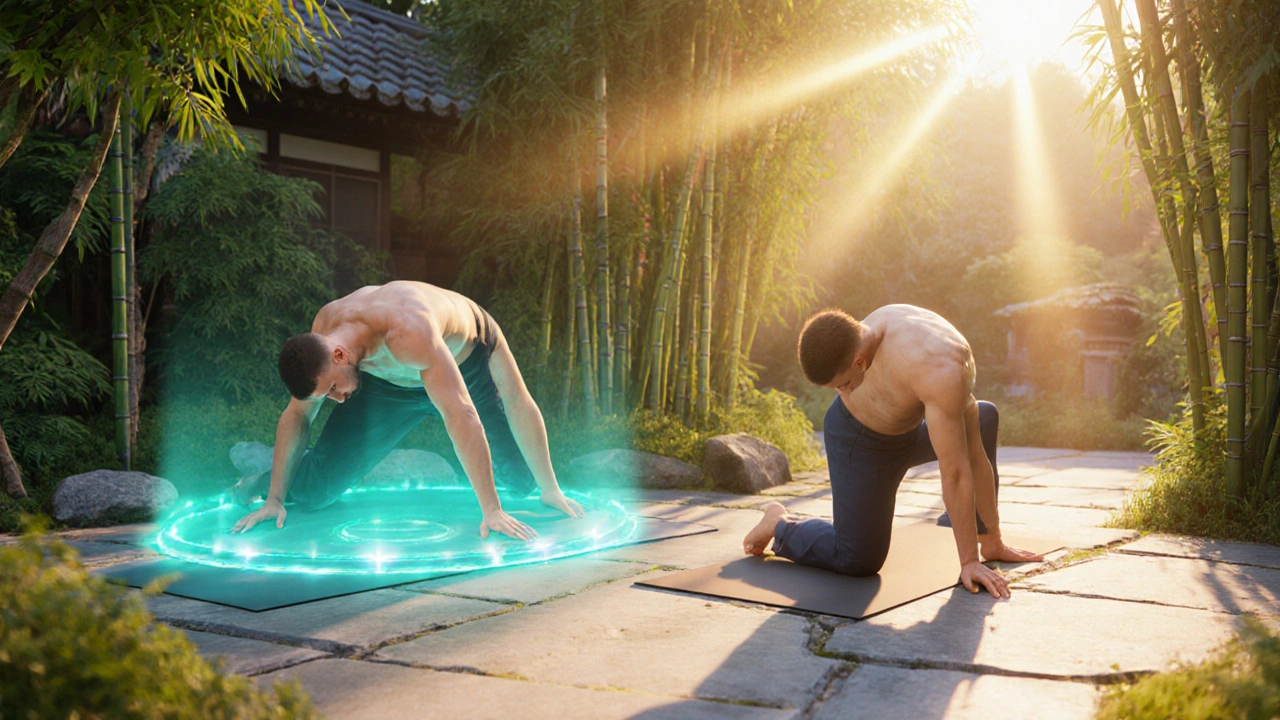
Combining Yoga and Meditation: A Simple Weekly Routine
- Morning Breathwork (5min): Sit comfortably, place one hand on the abdomen, inhale through the nose for a count of 4, hold 2, exhale slowly for 6. Repeat 10 cycles.
- Gentle Yoga Flow (20min):
- Cat‑Cow (5min) - mobilizes the spine and gently massages the pelvic area.
- Bridge Pose (3min) - hold for 30seconds, repeat 4 times.
- Happy Baby (5min) - hold each side for 45seconds.
- Supine Twist (5min) - each side for 1minute, eases lower back tension.
- Guided Mindfulness Meditation (10min): Use a free app or a simple script. Focus on the breath, notice thoughts about urinary urgency, and let them pass without judgment.
- Evening Stretch (5min): Seated forward bend to relax the hamstrings and reduce pelvic pressure before bed.
Consistency matters more than intensity. Even a 30‑minute daily habit can lower symptom scores within 6‑8 weeks.
Comparing Natural Practices with Conventional Medications
| Benefit | Yoga & Meditation | Alpha‑Blockers | 5‑Alpha Reductase Inhibitors |
|---|---|---|---|
| Improves urinary flow | Moderate - builds pelvic strength | High - relaxes smooth muscle | Low - shrinks gland over months |
| Reduces stress‑related urgency | High - lowers cortisol | Low - no direct effect | Low - no direct effect |
| Side‑effect profile | Minimal - occasional soreness | Dizziness, low blood pressure | Sexual dysfunction, decreased libido |
| Cost per month | Low - free videos or modest class fee | $30‑$70 (prescription) | $40‑$100 (prescription) |
Notice that yoga and meditation shine in areas medication can’t touch-stress control and overall well‑being. They’re not a replacement for drugs when severe obstruction exists, but they’re an excellent adjunct.
Safety Tips and Common Pitfalls
- Consult Your Doctor: If you’re already on prescription meds, ensure there are no contraindications.
- Avoid Over‑stretching: The pelvis is sensitive; stop any pose that causes sharp pain.
- Stay Hydrated, but Not Too Much: Drink enough water throughout the day, but limit fluids an hour before bedtime to reduce nighttime trips.
- Track Your Symptoms: Use a simple journal to note frequency, urgency, and flow strength. This helps you see progress.
Beyond Yoga: Complementary Lifestyle Moves
While yoga and meditation are powerful, pairing them with other habits can boost results:
- Nutrition: Foods rich in lycopene (tomatoes, watermelon) and omega‑3s (fatty fish) have been linked to lower prostate inflammation.
- Exercise: Regular brisk walking improves circulation to the pelvic region.
- Limit Caffeine & Alcohol: Both can irritate the bladder and worsen urgency.
- Mind‑Body Alternatives: Practices like Tai Chi and Mindfulness offer similar stress‑reduction benefits.
Key Takeaways
Yoga for enlarged prostate offers a low‑cost, low‑risk approach to easing urinary symptoms, lowering stress hormones, and improving pelvic muscle tone. When combined with daily meditation, men often report fewer nighttime trips and a calmer outlook on their condition. Start small, stay consistent, and use your symptom journal to celebrate progress.
Frequently Asked Questions
Can yoga replace my prescription medication for BPH?
Yoga is an excellent complement but not a full replacement for medication when the prostate enlargement is severe. Talk to your urologist before making any changes.
How often should I do the recommended routine?
Aim for a minimum of five days a week. Even short 15‑minute sessions can produce measurable benefits after a month.
Are there specific yoga poses to avoid?
Deep backbends that put pressure on the lower abdomen (like full wheel) may aggravate symptoms for some men. Stick to gentle forward‑folds and pelvic‑floor‑focused poses.
What length of meditation works best?
Begin with 5‑10 minutes and gradually increase to 20 minutes as you feel comfortable. Consistency beats duration.
Will practicing yoga affect my PSA levels?
Regular yoga can lower inflammation, which may modestly reduce PSA fluctuations, but it won’t dramatically change PSA on its own. Keep regular check‑ups with your doctor.

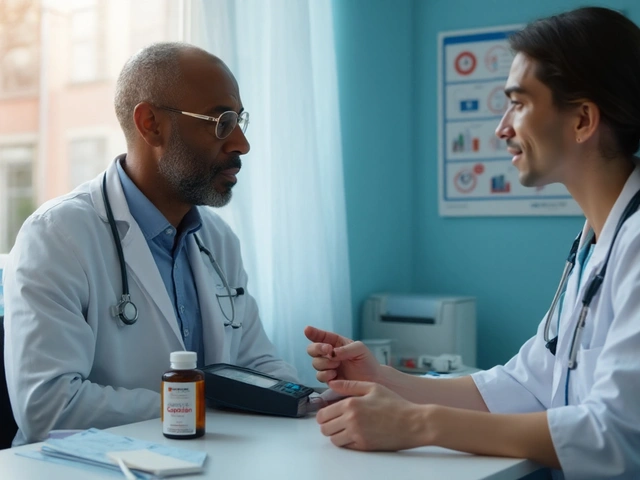
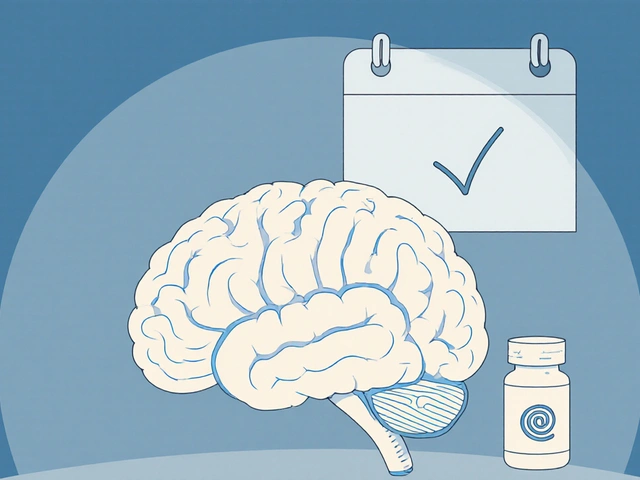
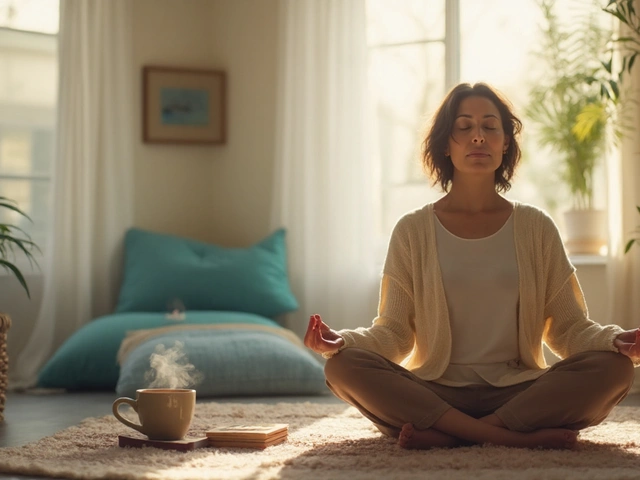
9 Comments
They don't want you to know that the pharma giants are hiding the real cure for BPH!!!
While yoga and meditation can complement traditional treatments, it's important to keep realistic expectations. A balanced routine that includes gentle pelvic floor exercises may reduce urgency without replacing prescribed medication. Always discuss any new regimen with your healthcare provider.
The so‑called “mind‑body” hype is just a marketing ploy to sell DVDs to men scared of aging. Sure, breathing exercises might calm nerves, but they won't shrink a swollen gland. Most readers ignore the core issue: poor diet and sedentary lifestyle, yet they cling to these trendy poses. It's a classic case of avoiding responsibility.
I get where you’re coming from, but many guys have actually felt better after just a few weeks 🙂. Incorporating simple stretches can improve circulation and lower stress, which in turn helps the prostate. Keep an open mind and give it a fair shot! 👍
Even small steps can lead to big improvements over time. Keep tracking your symptoms and celebrate each win! 😊
First, let me clarify that the human body operates on principles that have been understood for millennia, yet modern medicine often overlooks them. The prostate, like any gland, responds to hormonal balance, inflammation, and nerve signaling, all of which can be modulated by lifestyle choices. Yoga, when performed correctly, strengthens the levator ani and coccygeus muscles, providing mechanical support to the urethra. Meditation, on the other hand, reduces cortisol levels, thereby decreasing inflammatory cytokines that exacerbate BPH. Ignoring these simple interventions while relying solely on pharmaceuticals reflects a lack of personal responsibility. Moreover, the claim that meditation alone can “cure” BPH is a hyperbole that borders on misinformation. Consistency is key; sporadic practice yields negligible physiological change. The routine described in the article aligns with centuries‑old Ayurvedic recommendations for pelvic health. It is also supported by contemporary studies that show a modest reduction in PSA variability with regular breathwork. However, you must pair these practices with a diet rich in omega‑3s, lycopene, and limited saturated fats. Hydration timing, as noted, prevents nocturnal polyuria, a common oversight among patients. In addition, regular cardiovascular exercise enhances peripheral blood flow, further alleviating symptoms. It is crucial to monitor progress through a symptom diary; subjective reports without data are unreliable. Finally, always consult a urologist before altering any treatment plan, as surgical intervention may still be necessary in severe cases. By integrating mind‑body techniques with evidence‑based medicine, you achieve a holistic approach that respects both ancient wisdom and modern science.
Let's get moving and feel the difference! 🚀
Don't mistake enthusiasm for laziness-consistent, focused practice is what drives results. Skipping days will stall progress, so set a strict schedule and stick to it. Pair the sessions with proper hydration and avoid caffeine late at night. If symptoms persist, push for a medical review immediately.
Great job on taking the first step! Remember, it's okay to start slow and build momentum over weeks. Keep sharing your progress, and we’ll cheer you on together! 🌟